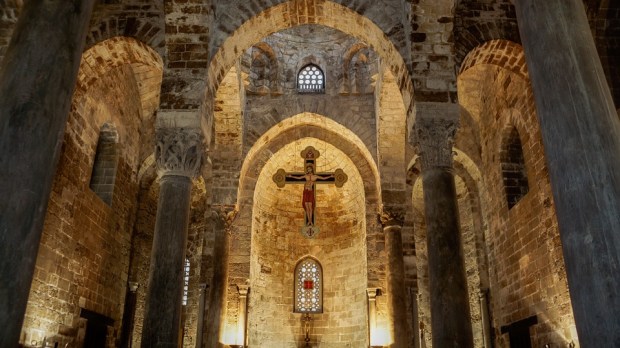Not long ago I was leading a mission in a suburban parish with a modern, fan-shaped church building. The welcome I received was kind and friendly, and the people were eager to learn more about their faith. The worship was simple and informal, but warmhearted and people-centered. The next weekend I led a mission at one of our historic cathedrals. The two experiences of worship and the two church buildings couldn’t have been more different.
The cathedral was filled with beautiful art. The music was uplifting and solemn. The architecture was soaring and the vaulted ceiling drew upward the eye and the heart. The best way to describe the cathedral experience was that it was vertical while the modern, fan shaped suburban church was horizontal. Everything about the cathedral worship lifted me toward heaven. Everything about the broad suburban church focused my heart and mind on the people present. This vertical and horizontal clash within American Catholicism is about more than just differing kinds of buildings.
After the second Vatican Council there was a real attempt by theologians and liturgists to democratize the Catholic faith and make it more people friendly. Along with the liturgy being in the vernacular, the priest faced the people and the congregation sat in a circular or semi circular arrangement around the altar. The church building and the liturgy was envisioned much more as the shared meal of the family of God rather than the sacred sacrifice of the Mass — offered by the priest on behalf of the people. The modern music that developed in Catholic communities was often centered more on the family of God and their mission to change the world than it was on the worship and praise offered to God. The Catholic experience became horizontal and too often the vertical was not only forgotten; it was purposefully absent.
Now, some 50 years after the revolution of the second Vatican Council, many Catholic communities are reestablishing some balance and reassessing the priorities of their life together. They’re discovering that, in fact, both the vertical and horizontal are required for Catholic life to be in balance. Furthermore, both the vertical and horizontal are intrinsically connected when they are properly ordered.
The best way to understand this is to think again about the two great commandments to love God and love our neighbor. When he was asked about the commandments Jesus said, “The first commandment is, ‘Love the Lord your God with all your heart, mind and strength. The second is love your neighbor as yourself’” (Matthew 22:38-39). In teaching this, Jesus established not only that the vertical relationship with God and the horizontal relationship to our neighbors are both necessary, but also that there is a priority.
Loving God is first. Therefore, the vertical is most important. The first priority is to get right with God. Worshipping God and learning to love him is our first task. From that divine love we then learn to love our neighbor. The two commandments are connected like the two beams of the cross. The vertical beam extends from earth to heaven and reminds us of the first commandment. The horizontal beam rests on the vertical beam and reminds us of the need to reach out to others.
Most problems in the Catholic religion as currently lived come back to an imbalance between the vertical and the horizontal aspect. When Catholics get so involved in peace and justice issues that they finally end up identifying themselves first by their political persuasion, rather than their faith, they have emphasized the horizontal love of neighbor to the exclusion or denigration of the vertical love of God.
Likewise, when a Catholic becomes so intent on worship, liturgy and prayer to the neglect of the corporal acts of mercy, he can become “so heavenly minded that he’s no earthly good” (1 Corinthians 3:18).
The balance needs to be restored. The vertical love of God is fulfilled by the horizontal love of neighbor, and the horizontal love of neighbor is inspired and empowered by the proper vertical love of God.
When I am conducting a parish mission I will remind people of these truths by reminding them that we are all called to take up our cross and follow Christ. When we cross ourselves on entering church we should remember how the cross itself teaches us the importance of the vertical and the horizontal. As we cross ourselves, we can remember to look up first in love for God and then to look to the right and left in the God-filled love of our neighbor.
Fr. Dwight Longenecker is a former Evangelical, then an Anglican priest, and now a Catholic priest. Visit his website at dwightlongenecker.com to browse his books and be in touch.

